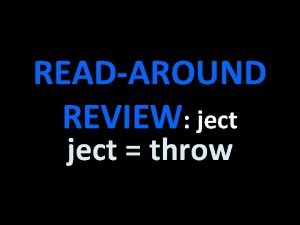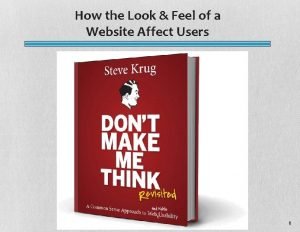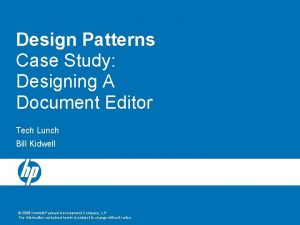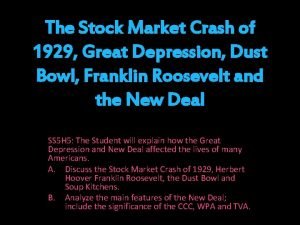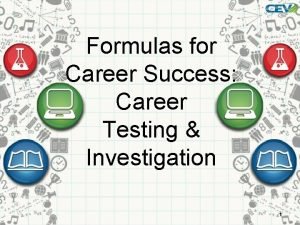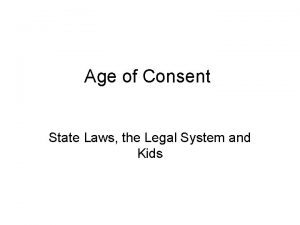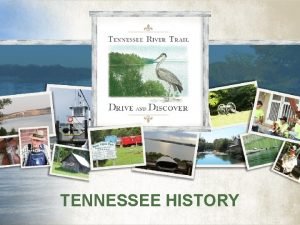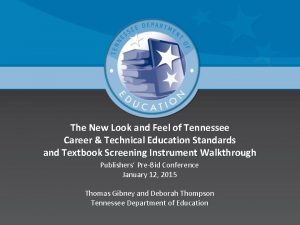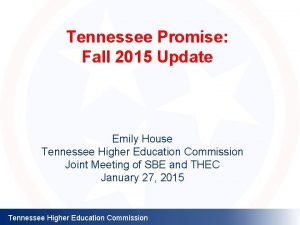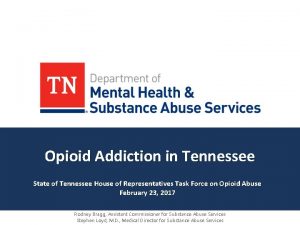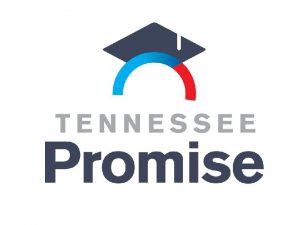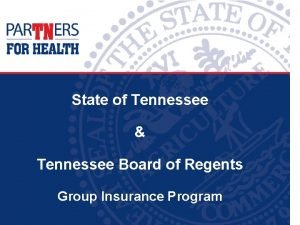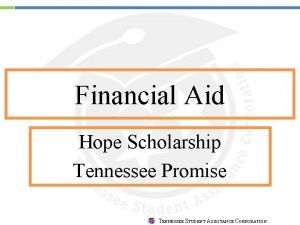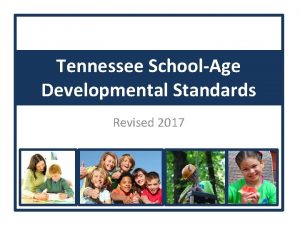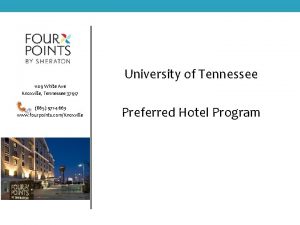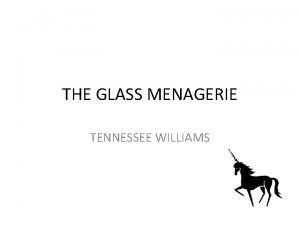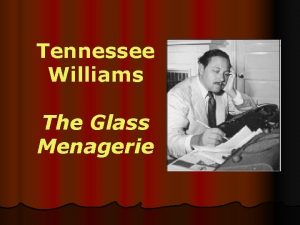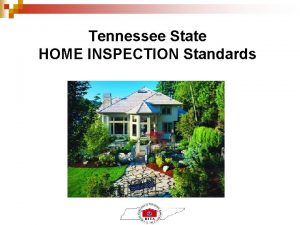The New Look and Feel of Tennessee Career











































- Slides: 43

The New Look and Feel of Tennessee Career & Technical Education Standards and Textbook Screening Instrument Walkthrough Publishers’ Pre-Bid Conference January 12, 2015 Thomas Gibney and Deborah Thompson Tennessee Department of Education

Welcome § Today we’re going to look at some of the key shifts in career and technical education standards revisions. § We will walk through examples and highlight changes to the Human Services, Education & Training, Advanced Manufacturing, and Information Technology career clusters. § Our goal is to provide you with a clear picture of the expectations surrounding the new standards, in order to inform robust textbook development and alignment. § There will be opportunities for group work and Q&A. Realizing Postsecondary and Career Readiness through CTE 2

A New Approach to Career & Technical Education What are the essential ingredients for student success? Realizing Postsecondary and Career Readiness through CTE 3

Realizing Postsecondary and Career Readiness through CTE 4

Tennessee State Standards General Education Math Courses Standards / Instruction Assessments Academic Learning STEM ELA Courses Social Studies Courses Career & Technical DC/DE Education Project Based Learning Technical Skill Attainment Writing Prompts Science Courses Citizenship Communication Skills Technology Fluency Team Work / Collaboration Work. Based Learning Problem Solving Sequential Courses Student Activities SAE Creativity Industry Certifications PD / Training Learning Environment Work Ethic Critical Thinking 21 st Century Skills Realizing Postsecondary and Career Readiness through CTE Career Cluster Programs of Study Robust, Aligned Academic/Career Student Learning Pathway 5

CTE Division: Theory of Action Realizing Postsecondary & Career Readiness Through CTE 6

Redefining Student Learning To meet the needs of Tennessee, our state’s Career & Technical Education must be a Robust, Aligned Academic/Career Learning Pathway Image Credit: Corporate Voices for Working Families Realizing Postsecondary & Career Readiness Through CTE 7

Early Postsecondary Opportunities Education and Industry Alignment Secondary/ Postsecondary Program Alignment Sustainable Student Pathways Student Pathway Components Education/ Career Transition Supports Rigorous, Relevant Courses and Student Plan “Data Mining” to Drive Decision Making Realizing Postsecondary and Career Readiness through CTE 8

What does a Pathway look like? • • RELEVANCE Work-Based Learning (grades 7 -14) Early Postsecondary Opportunities (Grades 9 -12) Career Awareness (Grades 7 -14) Stackable Credentials (Grades 9+) Middle School: Academic Foundation and Career Exploration • • • Technology College (Industry Certification) High School: Academic Core & Elective Focus Career Cluster: Advanced Manufacturing Program of Study: Mechatronics SUSTAINABLE Secondary & Postsecondary Academic Alignment Industry Engagement Community Engagement Realizing Postsecondary and Career Readiness Community College (A. A. /A. S) University or College (B. A. /B. S) CNC Operator $35, 580 Mechanical Engineering Technician $50, 660 Mechatronics Engineer $82, 440 Robust, Aligned Academic/Career 7 th-16 th Learning Pathway 9

Key Shifts in the New CTE Standards What to pay attention to when developing curricular materials Realizing Postsecondary and Career Readiness through CTE 10

Key Shifts 1. A shift to clear, specific, and measurable expectations for student learning. 2. Increased focus on rigor in literacy and mathematics within technical contexts. 3. Sequential progression of knowledge and skills within and across courses. Realizing Postsecondary and Career Readiness through CTE 11

1. Clear, specific, measurable expectations § The proficiency frameworks of years past relied on lengthy checklists of competencies that were often too procedural for the complex work in CTE courses § The new standards articulate deep knowledge and skill attainment, departing from the competency-based structure of years past § Our standards now describe proficiency at the standards level, often with embedded sample tasks meant to provide teachers with guidance on how to assess student learning Realizing Postsecondary and Career Readiness through CTE 12

Key Shifts: Look and Feel Retired: Nutrition and Foods 5. 0 Demonstrate ability to select, prepare and serve nutritious and aesthetically pleasing foods. 5. 1 Examine the effects of various kitchen designs, tools, equipment and technology on food preparation. 5. 2 Apply basic food preparation principles when preparing selected foods. 5. 3 Identify science principles of food preparation. 5. 4 Demonstrate appropriate dining etiquette and table service. 5. 5 Plan and evaluate individual and family meals. Realizing postsecondary and career readiness through CTE New: Nutrition Across the Life Span 6 Analyze a variety of meal plans (including three meals and two snacks daily) that meet nutritional requirements (caloric and RDA) as recommended by the U. S. Food and Drug Administration (FDA). Create a meal plan that addresses the nutritional needs of a specific individual based on their age, gender, activity level and other factors, and justify choices using evidence. Select, prepare, and serve food(s) from the meal plan following recipes precisely, including defining and utilizing specific culinary and measurement terms as needed. (TN Reading 1, 3, 4; TN Writing 7) 13

Your Turn § Take three minutes to read and discuss the following standard at your table. What is clear, measurable, and specific about this standard? Example: Introduction to Human Studies Standard 3 Research the development of self-esteem and self-image in individuals. Create a list of factors that promote and hinder the development of positive self-esteem and self-image. Formulate a plan to build/improve self-esteem in a class project or school based project. (TN Reading 2, 5; FACS 12) Realizing Postsecondary and Career Readiness through CTE 14

2. Rigor in literacy and mathematics § The new CTE standards align to all Tennessee State Standards for English Language Arts and Literacy in Technical Subjects and, where appropriate, select Tennessee State Standards in Mathematics § We are looking for textbooks that can draw out and devote major attention to the importance of literacy in technical contexts; as well as technical applications of mathematics § Strong textbooks will make use of authentic texts appropriate to the industry (i. e. , a schematic or a manual in an Advanced Manufacturing class), and provide frequent opportunities for applied writing and math Realizing Postsecondary and Career Readiness through CTE 15

Here’s an Example: Introduction to Human Studies Standard 3 Research the development of self-esteem and self-image in individuals. Create a list of factors that promote and hinder the development of positive self-esteem and self-image. Formulate a plan to build/improve self-esteem in a class project or school based project. (TN Reading 2, 5; FACS 12) § TN Reading 2: Determine the central ideas or conclusions of a text; trace the text’s explanation or depiction of a complex process, phenomenon, or concept; provide an accurate summary of the text. § TN Reading 5: Analyze the structure of the relationships among concepts in a text, including relationship among key terms (e. g. , force, friction, reaction force, energy). Realizing Postsecondary and Career Readiness through CTE 16

Here’s an Example Measure, weigh, and visually inspect machined parts. Record and compare data to given project specifications using class-defined analysis methods. Interpret and communicate results both written and verbally. If necessary, recommend changes that will reduce the number of product defects during the manufacturing process. (TN Reading 1, 3, 4, 7; TN Writing 1, 4; TN Math N-Q, G-GMD) § TN Math N-Q: Number and Quantity: Reason quantitatively and use units to solve problems. § TN Math G-GMD: Geometric Measurement and Dimension: (1) Explain volume formulas and use them to solve problems. (2) Visualize relationships between two-dimensional and three-dimensional objects. Realizing Postsecondary and Career Readiness through CTE 17

Your Turn § Take three minutes to read and discuss the following standard at your table. How do you envision this standard covered in an Information Technology Foundations textbook? What literacy supports or examples would you include to aid teacher instruction of this standard? Drawing on multiple sources (i. e. , internet, textbooks, videos, and journals), research the various social, legal, and ethical issues encountered by IT professionals. Using these findings, identify the roles and responsibilities one must consider while developing a prospective project or addressing an IT problem. For example, web developers and programmers must apply copyright laws understand uses of open source software. (TN Reading 1, 4) Realizing Postsecondary and Career Readiness through CTE 18

3. Sequential progression of knowledge and skills § The new standards build on each other both within course content and across course levels, arranged within programs of study that culminate in capstone and/or work-based learning experiences for students § Within a course, we want individual standards to serve as stepping stones toward a complete picture of proficiency § Across courses, the collective body of a student’s knowledge and skill should build sequentially to put him/her in a position to be successful after high school Realizing Postsecondary and Career Readiness through CTE 19

Student Pathway: Anatomy of Programs of Study Career Cluster Health Science Advanced Manufacturing STEM Agriculture Program of Study Level 1 Diagnostic Services Health Science Education Mechatronics Principles of Manufacturing Technology Agribusiness Level 2 Level 3 Anatomy and Physiology Diagnostic Medicine -and/or- Level 4 Cardiovascular Services -and/or- Medical Terminology Clinical Internship Digital Electronics Mechatronics II Principles of Engineering and Technology Digital Electronics Robotics & Automated Systems Engineering Practicum -and/or. AP Physics Agriscience Principles of Agribusiness Organizational Leadership and Communications Agricultural Business & Finance Supervised Agricultural Experience Robust, Integrated Learning Approach 1. General Education Courses 2. Lab Science Credit 3. Personal Finance Credit Realizing Postsecondary & Career Readiness Through CTE 4. Work-Based Learning Opportunities 5. Early Postsecondary Opportunities (Statewide/Local Dual Credit, Dual Enrollment, AP, etc) 20

Level to Level Progression Principles of Manufacturing (Level 1) Digital Electronics (Level 2) 27) Identify and describe the following components of a typical mechatronic system. Select a common machine, such as a robot or a copy machine, to illustrate an example of a mechatronic system. Using supporting evidence from the machine and/or its accompanying schematic, explain why the machine is considered a mechatronic system. a. Actuators b. Sensors c. Digital control devices d. Input devices e. Output devices f. Graphical displays (TN Reading 1, 2, 4, 7, 9) 19) Consult technical documents (such as data sheets, timing diagrams, operating manuals, and schematics) of digital components (TTL, CMOS, etc. ) to develop a troubleshooting methodology for a digital circuit that could be used by a new technician. Create and deliver a presentation demonstrating the troubleshooting procedure for the class. (TN Reading 3, 4, 5, 7; TN Writing 2, 4, 9) Realizing Postsecondary and Career Readiness through CTE 21

Another Example Fundamentals of Education (Level 1) 10) Compare and contrast physical, emotional, cognitive, and social milestones of development from toddlerhood through adolescence. Research and summarize, in an informative narrative, specific psychological theories about human development. Illustrate the differences in major developmental theories and milestones. (TN Reading 1, TN Writing 1; TN Psychology; FACS 12) Realizing Postsecondary and Career Readiness through CTE Teaching as a Profession I (Level 2) 2) Illustrate the stages of human development and the corresponding elements of effective instruction at each stage via graph, chart and/or illustration. Prepare an accompanying informative narrative to demonstrate knowledge of how students learn and develop at each stage. Provide examples of opportunities that support intellectual, social, and personal development. (TN Writing 2, 8, 9; TN Psychology; TN Sociology; FACS 4, 12) 22

Pulse Check § Can someone articulate for me what a program of study is under Tennessee’s new standards framework? § Why is it important for students to take courses that follow programs of study? § How will this knowledge impact your approach to the design of textbooks and other curricular supports? Realizing Postsecondary and Career Readiness through CTE 23

The New Look and Feel Digging deeper into our standards documents and language Realizing Postsecondary and Career Readiness through CTE 24

New Course Description Documents: Overview The new standards are best thought of as a framework for student learning and a roadmap for teachers to design quality lessons at a pace appropriate for the learning context of each specific classroom. They outline what students should know and do upon completion of the course in order to achieve proficiency in the subject matter… Realizing Postsecondary and Career Readiness through CTE …and be sufficiently prepared to pursue all the options available to them when they graduate from their chosen POS: postsecondary, career entry, advanced training, industry certification, and more. 25

New Course Description Documents: Overview Realizing Postsecondary and Career Readiness through CTE 26

Within the document, content headers group like standards together Realizing Postsecondary and Career Readiness through CTE 27

New Course Description Documents: Look and Feel Nutrition Across the Lifespan 5) Accurately read, interpret, and communicate understanding of guidance from the U. S. Food and Drug Administration (FDA), and other regulators, such as nutrition labels and daily value recommendations using accurate symbols, key terms, and other domain-specific words and phrases. (TN Reading 4; FACS 9, 14) 7) Analyze a variety of meal plans that meet nutritional requirements (caloric and RDA) as recommended by the U. S. Food and Drug Administration (FDA). Create a meal plan that addresses the nutritional needs of a specific individual based on their age, gender, activity level and other factors, and justify choices using evidence. Select, prepare, and serve food(s) from the meal plan following recipes precisely, including defining and utilizing specific culinary and measurement terms as needed. Practice proper serving and etiquette principles during appropriate situations. (TN Reading 1, 3, 4; TN Writing 7; FACS 9, 14) Realizing Postsecondary and Career Readiness through CTE 28

Your Turn Course Description Document Read-Through Take 3 minutes to skim through the full course description document for a course in your folder. Get out a pen and take notes using the following conventions: ? * I have a question about this. This will be important for me. Realizing postsecondary and career readiness through CTE 29

Ultimately, how do we ensure that our students experience rigorous and robust learning pathways that provide real options upon graduation? Realizing Postsecondary & Career Readiness Through CTE 30

Questions before we break? Realizing Postsecondary and Career Readiness through CTE 31

Part II: Screening Instrument Walkthrough Realizing Postsecondary and Career Readiness through CTE 32

Before We Begin… There are several things to know about the screening instruments prior to jumping in. § First, there is more than one. In a similar way that last year’s math instruments were differentiated by middle grades, high grades, and advanced topics, CTE screening instruments for Section A subjects have mostly been developed by program of study. (There a few exceptions. ) § Second, all instruments include three non-negotiable components: (1) focus, (2) rigor, and (3) postsecondary and career readiness. § Third, negotiable components vary by program of study. Because of the great variation in CTE subjects—even within career clusters—screening instruments have also been developed to be sensitive to the curricular needs of each program of study. Realizing Postsecondary and Career Readiness through CTE 33

There are 12 total instruments for Section A Machining Technology Advanced Manufacturing (x 4) Electromechanical Technology Mechatronics Welding Information Technology (x 3) Programming & Software Development Networking Systems Web Design Human Services (x 3) Childhood Development Services Social Health Services Dietetics & Nutrition Education & Training (x 1) 1 for all POS + 1 for aligned Middle School CTE courses Realizing Postsecondary and Career Readiness through CTE 34

Example: Mechatronics § Take a few moments to glance at the screening instrument as we’re passing it out. This instrument is aligned to the Mechatronics program of study (POS) in the Advanced Manufacturing career cluster. Realizing Postsecondary and Career Readiness through CTE 35

Walkthrough § We’re going to walk through each section of the instrument and discuss its negotiable and non-negotiable components, as well as the scoring system associated with each. § Please raise questions as they come up. Feel free to mark up your copy with the conventions we used this morning: ? * I have a question about this. This will be important for me. § Order of the rubric: • Section I: Non-negotiables • Section II: Negotiables • Section III: Focus area (optional) Realizing Postsecondary and Career Readiness through CTE 36

Section I: Non-negotiables Take 5 minutes to read this section on your own. § Focus § Rigor § Postsecondary and Career Readiness **Aligned materials must meet all three non-negotiable components in order to be eligible for consideration!** Realizing Postsecondary and Career Readiness through CTE 37

Section II: Negotiables Take 5 minutes to read this section on your own. § Additional Alignment Criteria § Sequence and Progression of Standards § Teacher Supports § Usability § Assessments Realizing Postsecondary and Career Readiness through CTE 38

Section III: Focus Area § This is an optional section of the instrument designed to capture qualitative observations on an additional area of focus, if presented in the materials. § For example, a Mechatronics textbook (or suite of textbooks, spanning multiple grade levels) could have a distinct focus in robotics. The instrument allows reviewers to recognize such a focus as a distinguishing aspect or additional value offered by this book. Realizing Postsecondary and Career Readiness through CTE 39

Table Time § Now that we’ve walked through a sample instrument, take some time to discuss at your tables. Some key questions you may want to consider include the following: • How does the design of the instrument impact how we will approach drafting our materials? • What questions do we have about the individual components? About the scoring system? • What resources will we consult to develop our textbooks? Given the emphasis on literacy in technical contexts (and, where appropriate, on math), how will we support teachers with the activities and texts we include in our materials? Realizing Postsecondary and Career Readiness through CTE 40

Final Q&A Realizing Postsecondary and Career Readiness through CTE 41

Thomas Gibney Program Manager, Student Success Division of Career and Technical Education Tennessee Department of Education Thomas. Gibney@tn. gov (615) 253 -3223 Deborah Thompson Career Cluster Consultant Division of Career and Technical Education Tennessee Department of Education Deborah. Thompson@tn. gov (615) 532 -2840 www. tn. gov/education/cte www. TNCore. org Realizing Postsecondary and Career Readiness through CTE 42

 Look up and down gif
Look up and down gif Ject root
Ject root Who creates the look and feel of a website
Who creates the look and feel of a website Designing a document editor in design patterns
Designing a document editor in design patterns New deal tennessee valley authority
New deal tennessee valley authority Vocabulary review causes of the depression
Vocabulary review causes of the depression Look good feel good quote
Look good feel good quote National career clusters framework
National career clusters framework Formulas for career success
Formulas for career success Career portfolio definition
Career portfolio definition You make me feel brand new
You make me feel brand new Activity 1 image
Activity 1 image Activity 1 image
Activity 1 image Activity 1 a) look at the picture
Activity 1 a) look at the picture Romeo and juliet law tennessee
Romeo and juliet law tennessee Tennessee sales and use tax blanket certificate of resale
Tennessee sales and use tax blanket certificate of resale Hình ảnh bộ gõ cơ thể búng tay
Hình ảnh bộ gõ cơ thể búng tay Frameset trong html5
Frameset trong html5 Bổ thể
Bổ thể Tỉ lệ cơ thể trẻ em
Tỉ lệ cơ thể trẻ em Voi kéo gỗ như thế nào
Voi kéo gỗ như thế nào Tư thế worm breton là gì
Tư thế worm breton là gì Chúa yêu trần thế
Chúa yêu trần thế Môn thể thao bắt đầu bằng chữ f
Môn thể thao bắt đầu bằng chữ f Thế nào là hệ số cao nhất
Thế nào là hệ số cao nhất Các châu lục và đại dương trên thế giới
Các châu lục và đại dương trên thế giới Công thức tính thế năng
Công thức tính thế năng Trời xanh đây là của chúng ta thể thơ
Trời xanh đây là của chúng ta thể thơ Mật thư tọa độ 5x5
Mật thư tọa độ 5x5 Phép trừ bù
Phép trừ bù Phản ứng thế ankan
Phản ứng thế ankan Các châu lục và đại dương trên thế giới
Các châu lục và đại dương trên thế giới Thể thơ truyền thống
Thể thơ truyền thống Quá trình desamine hóa có thể tạo ra
Quá trình desamine hóa có thể tạo ra Một số thể thơ truyền thống
Một số thể thơ truyền thống Cái miệng nó xinh thế chỉ nói điều hay thôi
Cái miệng nó xinh thế chỉ nói điều hay thôi Vẽ hình chiếu vuông góc của vật thể sau
Vẽ hình chiếu vuông góc của vật thể sau Nguyên nhân của sự mỏi cơ sinh 8
Nguyên nhân của sự mỏi cơ sinh 8 đặc điểm cơ thể của người tối cổ
đặc điểm cơ thể của người tối cổ Thế nào là giọng cùng tên? *
Thế nào là giọng cùng tên? * Vẽ hình chiếu đứng bằng cạnh của vật thể
Vẽ hình chiếu đứng bằng cạnh của vật thể Phối cảnh
Phối cảnh Thẻ vin
Thẻ vin đại từ thay thế
đại từ thay thế

